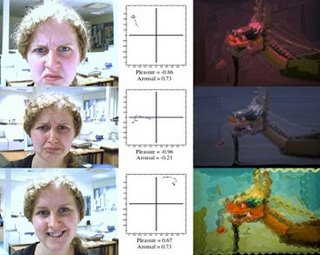Imagining Terrorism: TSA "Precognition" and Computer Recognition of Emotions
 Boing Boing published an item on the Empathic Painting Project a while back and I've been thinking off and on about it ever since, without incident. It reminded me a bit of Komar and Melamid's Most Wanted Paintings project, except without the irony, certainly more of a science experiment than a concerted effort at artistic expression.
Boing Boing published an item on the Empathic Painting Project a while back and I've been thinking off and on about it ever since, without incident. It reminded me a bit of Komar and Melamid's Most Wanted Paintings project, except without the irony, certainly more of a science experiment than a concerted effort at artistic expression.
The technique might be more interesting in installation art than painting, which would give viewer emotions a dramatic influence over a space through their real or expressed mood. One great technological advance would be for a computer to interpret the collective mood of a group of people in the space, or to scan a variety of faces and interpret that information in some other way. This would provide real and socially useful information and making manipulation of the machine much more difficult - and, if achieved, much more interesting! Of course, ideas like this are a creative inversion of the real work going on in this technology, a serious project which has plenty of 1984-style ramifications as well as the potential to save lives. (How often the two go hand in hand.) The New York Times published an article in late August about the U.S. Transportation Safety Administration's "behavior detection officers," an expanded cadre of officials who assess the facial expressions of would-be passengers in search of terrorist intent. Apparently, according to the graphic above, you must be happy, confused, or bored out of your mind in order to not look like a terrorist.
Of course, ideas like this are a creative inversion of the real work going on in this technology, a serious project which has plenty of 1984-style ramifications as well as the potential to save lives. (How often the two go hand in hand.) The New York Times published an article in late August about the U.S. Transportation Safety Administration's "behavior detection officers," an expanded cadre of officials who assess the facial expressions of would-be passengers in search of terrorist intent. Apparently, according to the graphic above, you must be happy, confused, or bored out of your mind in order to not look like a terrorist.
The Times takes the comforting tone of playing up the scientific nature of such screenings, but TSA officials admit that their techniques are not perfect. Put at its most ironic, their facial recognition techniquees are most limited by the fact that they "catch" a variety of emotions - fear, anger, frustration, stoicism - that are quite common among people going through post-9/11 security checkpoints!
I suspect that science will soon catch up with art, and human "behavior detection" screens will begin to look very... 20th century.







No comments:
Post a Comment